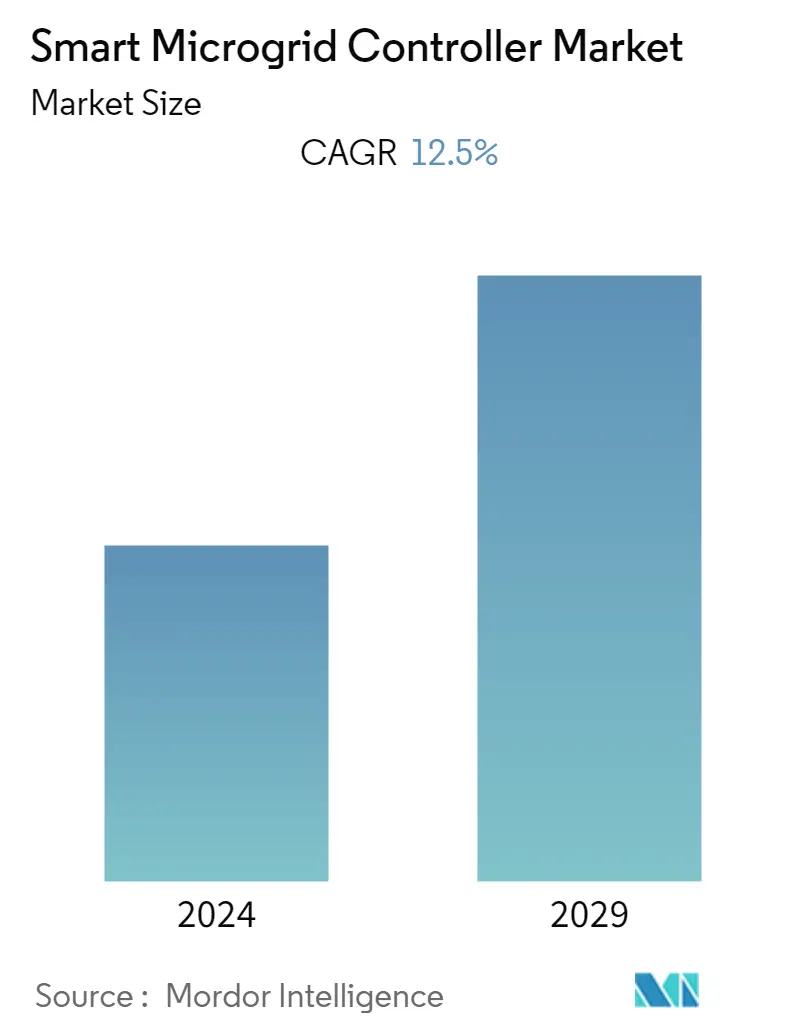Market Size of Smart Microgrid Controller Industry

| Study Period | 2019 - 2029 |
| Base Year For Estimation | 2023 |
| CAGR | 12.50 % |
| Fastest Growing Market | Asia Pacific |
| Largest Market | North America |
| Market Concentration | Medium |
Major Players
*Disclaimer: Major Players sorted in no particular order |
Smart Microgrid Controller Market Analysis
The Smart Microgrid Controller Market is expected to register a CAGR of approximately 12.5% during the forecast period (2021 - 2026). Trends pertaining to Digitization, Decentralization, and Electrification are leading to a paradigm shift in the energy landscape.
- An integrated smart microgrid controller cost-effectively maintains grid stability and operational resiliency. A smart microgrid controller automates all microgrid components' control to satisfy power demand and maintain stable operating conditions with minimal operational staffing and intervention from human resources.
- According to an estimate by the International Energy Agency, 42% of new energy generation capacity additions should be generated from microgrids to achieve the United Nations Sustainable Development goal of 100% energy access by 2030.
- A controller software maximizes electric reliability, integrate renewables, or reduce emissions. In April 2020, HOMER Energy, by UL recently released, introduced two powerful, customizable Controller APIs, which enable the users to create and simulate their dispatch strategy in HOMER Grid software for modeling the design of behind-the-meter distributed energy systems.
Smart Microgrid Controller Industry Segmentation
A Microgrid is a contiguous section of the grid consisting of interconnected Distributed Energy Resources (DERs) and loads under common control. DERs can be distributed renewables, storage devices, generators, electric vehicles, and demand response. Smart Microgrid controls are capable of optimizing the power mix of the DERs and loads to provide reliable and economical operation to the end-users without human intervention.
As part of the scope of the study, both Grid-connected and Remote Microgrid controllers have been included. The utilization of microgrid controllers across major end-users such as Communities, Commercial/Industrial, Utilities, and Educational Institutions, among others, has been considered.
| By Connectvity | |
| Grid Connected | |
| Remote/Off Grid |
| By End-user Vertical | |
| Commercial and Industrial | |
| Power & Utilities | |
| Institutional/Campus | |
| Government/Communities | |
| Other End-user Verticals |
| Geography | |
| North America | |
| Europe | |
| Asia-Pacific | |
| Latin America | |
| Middle East & Africa |
Smart Microgrid Controller Market Size Summary
The Smart Microgrid Controller Market is experiencing significant growth, driven by trends in digitization, decentralization, and electrification, which are transforming the energy sector. These controllers play a crucial role in maintaining grid stability and operational resilience by automating the control of microgrid components to meet power demands with minimal human intervention. The integration of renewable energy sources and the reduction of emissions are key features of these systems, which are becoming increasingly important as the world moves towards sustainable energy solutions. The market is characterized by innovations such as customizable Controller APIs and urban microgrid solutions, which enhance energy storage and management capabilities. The adoption of grid-connected microgrid controllers is particularly favored by homeowners and small enterprises due to their cost-effectiveness.
North America is poised to lead the Smart Microgrid Controller Market, fueled by the growing adoption of renewable energy and distributed generation systems. The region's focus on sustainable microgrids is a response to climate change and natural disasters, as well as the need to modernize aging energy infrastructure. The market is moderately fragmented, with numerous players engaging in strategic partnerships and collaborations to enhance their market presence. Notable developments include the launch of agile microgrid solutions and advanced control systems for integrating renewable energy in off-grid applications, such as mining. These innovations are expected to drive the market forward, offering cost-effective and reliable power solutions in various sectors.
Smart Microgrid Controller Market Size - Table of Contents
-
1. MARKET DYNAMICS
-
1.1 Market Overview
-
1.2 Market Drivers
-
1.2.1 Significant Growth in a Range of Distributed Energy Resources (DER)
-
1.2.2 Growing Government Investments Toward Microgrid Projects
-
-
1.3 Market Restraints
-
1.3.1 Complexity Regarding Coordination between Inverters from Different Vendors Having Different Operational Standards
-
-
1.4 Industry Attractiveness - Porter's Five Forces Analysis
-
1.4.1 Threat of New Entrants
-
1.4.2 Bargaining Power of Buyers/Consumers
-
1.4.3 Bargaining Power of Suppliers
-
1.4.4 Threat of Substitute Products
-
1.4.5 Intensity of Competitive Rivalry
-
-
1.5 Microgrid Business Models Landscape
-
1.6 Assessment of Impact of COVID-19 on the Global Microgrid Control Systems Market
-
-
2. MARKET SEGMENTATION
-
2.1 By Connectvity
-
2.1.1 Grid Connected
-
2.1.2 Remote/Off Grid
-
-
2.2 By End-user Vertical
-
2.2.1 Commercial and Industrial
-
2.2.2 Power & Utilities
-
2.2.3 Institutional/Campus
-
2.2.4 Government/Communities
-
2.2.5 Other End-user Verticals
-
-
2.3 Geography
-
2.3.1 North America
-
2.3.2 Europe
-
2.3.3 Asia-Pacific
-
2.3.4 Latin America
-
2.3.5 Middle East & Africa
-
-
Smart Microgrid Controller Market Size FAQs
What is the current Smart Microgrid Controller Market size?
The Smart Microgrid Controller Market is projected to register a CAGR of 12.5% during the forecast period (2024-2029)
Who are the key players in Smart Microgrid Controller Market?
Schweitzer Engineering Laboratories, Schneider Electric SE, Opus One Solutions Inc., Encorp Inc. and Siemens AG are the major companies operating in the Smart Microgrid Controller Market.

